




Connected Experiences and the Value of Post Purchase ‘Physical’ Data
What is ‘post-purchase physical’ data?
The first part is pretty obvious, data that you collect post purchase. The second part is the more interesting and unknown part, ‘Physical data’ is data that is generated by a consumer interacting with your product, packaging, or media. Put the two together, and we're talking about insights into how your consumer interacts with your product post purchase.
Usually this kind of data would be collected via follow up surveys, feedback forms, and other survey based approaches asking a consumer about whether they enjoyed your product, how they used it, where they used it, and if they would use it again or recommend it to others. We think there is a better way to get these insights.
How do connected experiences capture this data?
The simple answer is by turning your own product and packaging into a media channel that you own and control and then using it to engage your consumer. But how I hear you ask? Well, let’s look at some practical examples.
We worked with Boots on their range of TENS machines – designed to provide relief from muscle pain using electrodes to conduct current. Prior to our involvement with the brand, once the customer bought the product and left the shop there was a vacuum of information… until a review appeared online or a customer survey was sent out.
We created a connected experience for Boots that helped the consumer better use their device. It included video instructions on how to wear the device and it gave them a pain diary to track the efficacy of the treatment. All this via a nice QR code on pack.
This simple connected experience enabled Boots to gain valuable insights on how its consumers were using its devices, informed them how to better communicate which devices consumers should buy and also resulted in an overall increase in satisfaction in online reviews.
Another example is Yeo Valley, which through adding QR codes to its entire product line was able to see that most scans were taking place in the morning and evening, informing the brand’s content strategy for the creation of recipes that focused on breakfast foods like muesli and evening meals like curry, to encourage increased usage and purchase.
And finally, working with a CPG brand using NFC we were able to challenge their belief that their product had a life of ‘three days in pocket’ by showing them that scans were taking place up to three weeks after the initial scan.
All of these examples included different connected experiences, but all were only possible by adding a digital trigger – QR code or NFC tag – that had turned the clients product into a direct media channel with their consumer.
What type of data can you capture?
When we talk about data collection, we’re talking about two different kinds of data. The first is the interaction data – the data generated by the consumer’s interaction with the QR code or NFC tag - such as where, when or what device was used etc. The second is the first party data given by a consumer as part of the associated experience – entering emails, names etc as part of competitions or joining loyalty schemes or accessing promotions etc.
What can you do with the data you capture?
In a post purchase environment, the focus is often on areas such as maintenance or support, feedback or satisfaction, the detection of usage patterns – by day, time, location or contextualised by things such as weather (depending on the sophistication of the connected experience) or even upsell and cross-sell.
Once you have captured the data through these different connected experiences, you can then deploy it across your business. In the marketing world you will be filling in the blanks you have in your CRM or CDP, generating new insights by adding the data you have collected to your existing profiles and customer knowledge base. You can also use the data to generate insights that can be folded back into your new product development or to create more personalised connected experiences or recommendations or enhance your existing customer support capabilities.
io.tt has advanced reporting and AI insights that allow you to create useful conclusions from the data you get from your QR codes and NFC tags - talk to our team today or start a free trial to see how our platform can help your brand.
